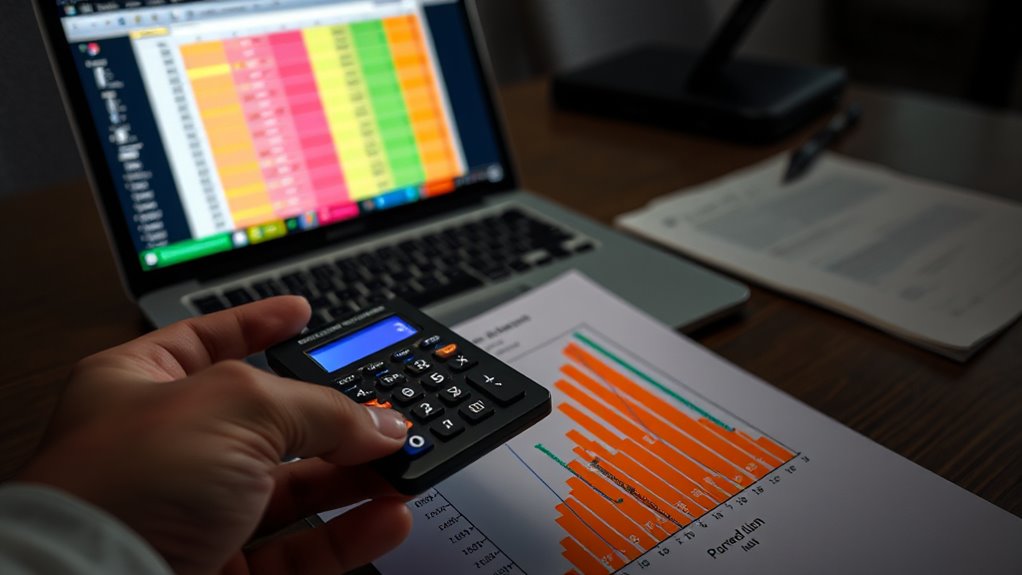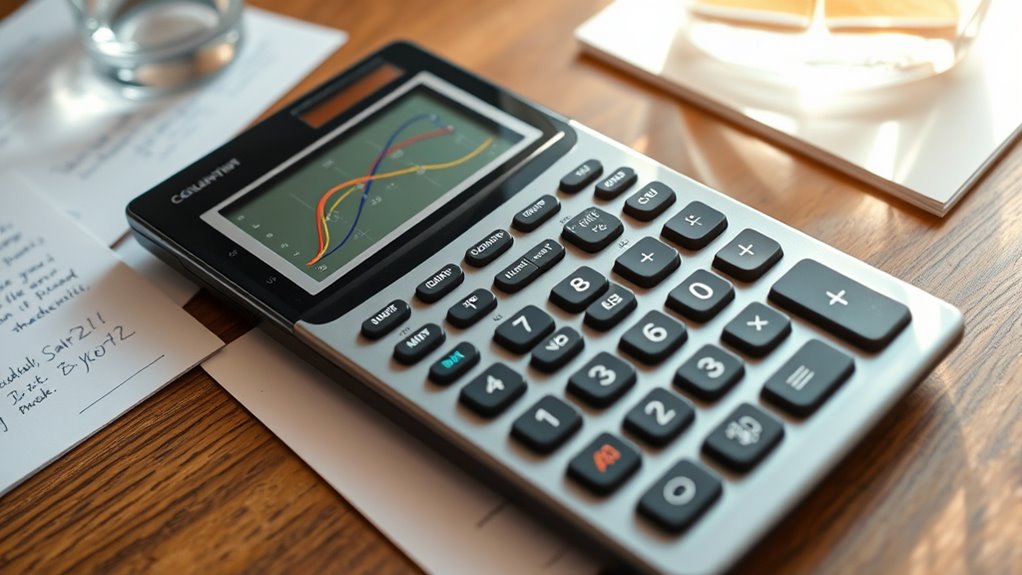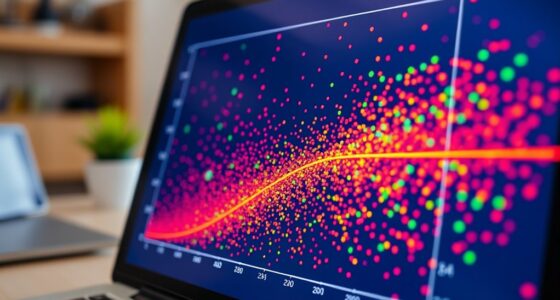To calculate correlation coefficients, start by gathering reliable data for the two variables you’re interested in. Convert each data point into z-scores by subtracting the mean and dividing by the standard deviation. Then, multiply each pair of z-scores and sum these products. Next, compute the covariance and divide it by the product of the two variables’ standard deviations to get the correlation. If you keep exploring, you’ll discover detailed steps and methods to guarantee accurate results.
Key Takeaways
- Collect paired data for both variables and ensure quality and sufficient sample size.
- Calculate the mean and standard deviation for each variable to standardize data into z-scores.
- Multiply paired z-scores and sum these products to find the numerator for the correlation coefficient.
- Compute the standard deviations and covariance to determine the denominator for the Pearson correlation.
- Divide the covariance by the product of standard deviations to obtain the correlation coefficient, ranging from -1 to 1.
Gathering and Preparing Data

Gathering and preparing data is a crucial first step in calculating correlation coefficients because the quality of your data directly affects the reliability of your results. First, identify relevant variables that are logically connected or hypothesized to have an association. Collect data from trustworthy sources to verify it accurately represents your population or phenomenon. Check for data quality issues like missing values, outliers, or errors that could distort your analysis. Make sure your sample size is large enough to produce reliable estimates. Additionally, ensuring that your data includes farmhouse furniture characteristics can help target specific relationships within interior design contexts. Also, confirm that variables are measured on appropriate scales—preferably continuous for Pearson correlation. Properly preparing your data helps prevent inaccuracies and ensures your correlation analysis reflects true relationships, setting a solid foundation for meaningful insights. Recognizing pinball machine weights can also be relevant when considering physical data aspects or logistical planning for equipment setup.
Calculating Standardized Values (Z-scores)

Calculating standardized values, known as z-scores, is a key step in understanding the relationship between variables in correlation analysis. To do this, subtract the mean from each raw data point and divide by the standard deviation using the formula ( z = frac{(x – mu)}{sigma} ). This process transforms data into standardized scores with a mean of zero and a standard deviation of one, enabling comparisons across different datasets. Z-scores reveal how far each value is from its mean in terms of standard deviations and help identify outliers. When analyzing correlation, converting raw scores into z-scores makes it easier to compare variables measured on different scales and simplifies calculations. This standardization is essential for accurately evaluating the strength and direction of relationships between variables, especially in contexts like juice cleansing where variables like nutrient intake can vary widely. Additionally, understanding the impact of data standardization in various fields can improve the accuracy of statistical inferences.
Computing the Sum of Products of Paired Z-scores

To understand the strength and direction of the relationship between two variables, you need to compute the sum of the products of paired z-scores. First, multiply each pair of z-scores from your variables to get the cross-products. Then, add all these products together to find the total sum. This sum reflects how the z-scores relate—positive products indicate similar signs, while negative products show opposite signs. The larger the sum, the stronger the relationship, either positive or negative. If the sum is close to zero, it suggests little to no correlation. This step is *vital* because it captures the overall tendency of the paired z-scores to increase or decrease together. Remember, the sum of these products forms the numerator in calculating the correlation coefficient. Understanding correlation helps interpret what this sum indicates about your data, especially when considering efficient general ledger coding to ensure accurate financial data analysis.
Determining the Denominator Using Variance Measures

After computing the sum of the products of paired z-scores, the next step is to determine the denominator of the correlation coefficient, which involves variance measures. Variance measures how much data points deviate from the mean, with the formula averaging the squared differences. The standard deviation is simply the square root of this variance, providing a normalized measure of spread. These standard deviations are essential because they scale the covariance, ensuring the correlation coefficient stays within -1 to 1. When you multiply the standard deviations of both variables, you get the denominator that adjusts for units and variability, making the correlation measure dimensionless and comparable across datasets. Additionally, understanding how AI security vulnerabilities impact model reliability can inform more robust safety measures. Recognizing the role of variance measures in statistical analysis helps ensure accurate and meaningful correlation calculations.
Final Calculation of the Correlation Coefficient

The final step in determining the correlation coefficient involves applying the formula that combines your previous calculations. First, you need the covariance, which is the sum of the products of deviations from the means for each data point. Next, divide this sum by the total number of data points minus one to get the covariance. Then, find the standard deviations of both variables, which involve calculating the square root of the sum of squared deviations divided by the degrees of freedom. Finally, divide the covariance by the product of the two standard deviations. This yields the Pearson correlation coefficient, a value between -1 and 1 that indicates the strength and direction of the linear relationship between your variables. Understanding the formula is crucial for accurate calculations. Precise calculations here are essential for reliable results.
Interpreting the Results and Recognizing Limitations

Interpreting the correlation coefficient involves understanding both its sign and magnitude. A positive value means the variables move together in the same direction, while a negative indicates they change inversely.
The absolute value shows the strength: closer to 1.0 means a stronger relationship, while near 0 suggests a weak link. For example, 0.9 signifies a very strong correlation, whereas 0.2 is weak.
Keep in mind, correlation doesn’t imply causation, and most coefficients assume a linear relationship. Outliers can distort results, so always check your data.
Remember that context matters—what’s strong in one field might be weak in another. Use correlation coefficients as a tool for initial insights, but avoid overinterpreting their limitations.
Additionally, understanding the horsepower of electric dirt bikes can help contextualize the strength of relationships in performance metrics. Recognizing breed-specific traits can also influence how you interpret correlation results for different dog breeds.
Frequently Asked Questions
How Do Outliers Affect the Accuracy of Correlation Coefficients?
Outliers can considerably affect the accuracy of correlation coefficients. When you have outliers, they increase data scattering, which weakens the apparent relationship between variables.
If outliers are extreme or not aligned with the trend, they tend to lower the correlation coefficient, making it less reliable. Conversely, if they follow the trend, they might artificially inflate the correlation, misleading your interpretation.
Managing outliers helps guarantee your correlation accurately reflects the data’s true relationship.
When Should I Use Spearman’s Versus Pearson’s Correlation?
Like choosing the right map for your journey, you select Spearman’s when your data’s path is curved or outliers hide the true route, indicating a monotonic relationship.
Use Pearson’s when your data follows a straight road — linear, normally distributed, and free of outliers.
If you’re unsure, plot your data first.
Spearman handles rank-based, non-linear relationships, while Pearson excels in linear, parametric scenarios.
Can Correlation Imply Causation Between Variables?
You might wonder if correlation implies causation, but it doesn’t. When you see two variables moving together, it suggests an association, but it doesn’t prove one causes the other.
To establish causation, you’d need controlled experiments that manipulate variables and rule out other factors.
Relying solely on correlation can lead you to false conclusions, so always be cautious before assuming cause-and-effect relationships.
What Are Common Mistakes in Calculating Correlation Manually?
When calculating correlation manually, you might stumble like a tightrope walker without a safety net. Common mistakes include miscalculating means, which skews results, or forgetting to update variables during calculations.
Rounding errors, misordering operations, and ignoring data assumptions like linearity and independence can also trip you up. To stay balanced, double-check formulas, verify assumptions, and consider using software to minimize human error and guarantee accurate results.
Which Software Tools Are Best for Correlation Analysis?
You’re wondering which software tools are best for correlation analysis. You should consider NCSS and XLSTAT, as they’re user-friendly and offer extensive features for different data types.
Minitab is also excellent for detailed analysis, while Excel with add-ons like Real Statistics makes calculations accessible.
Many of these tools provide free trials, so you can test their capabilities before committing, ensuring you find the best fit for your needs.
Conclusion
Now that you know how to calculate correlation coefficients, you’re ready to uncover relationships between data sets like a modern-day Sherlock. Just remember, while the process is straightforward, always interpret your results carefully—correlation isn’t causation. Think of it as steering the stars in an old ship; understanding the signs guides you, but don’t forget the ocean’s mysteries. With practice, you’ll master this skill faster than a knight drawing his sword!










